
For a brief period at the end of November, nature turns the tables and pushes Kyoto’s architectural gems to background scenery. Like leafpeeping in New England, momijigari is popular in Japan, but New England doesn’t have five-storied pagodas and expansive temple grounds dating back centuries.
Accordingly, the two best spots to view the foliage combine nature with national treasures. Last year I blogged about Nikko. This year I took a bullet train to my date with the belle of the autumnal ball.
There wasn’t a hotel room left in the city. I joined the throngs lining up to enter temples and their outdoor rock gardens (above photo). Mobbed doesn’t even begin to describe the pedestrian traffic, but gazing up at the leaves made the dark coats with clicking Canons fade from consciousness. 
Despite being peak season, most of the trees remained green. However, certain species like the Japanese maple and gingko turned the spotlight on themselves and vied for my attention. In Japan’s premier architectural setting, nature, too, was at its finest. Foliage in Kyoto combines the best of nature’s and man’s accomplishments, so sit back and enjoy the pictures.
Kyoto in late September 2006.
Kyoto in late November 2006.
Before heading back to Tokyo, I stopped in nearby Uji for a look at Phoenix Hall (below), which is featured on the back of the 10 yen coin. Uji is also famous for tea. At a teahouse near Phoenix Hall I participated in a private ceremony, which got off to an inauspicious start when I slammed my forehead into the doorframe just after removing my shoes. Participate isn’t really the right word, as the only thing I did was get bowed to. Two kimono-clad ladies prepared a cup of rich green tea before my very eyes, which took a little more precision than adding hot water to a mix. The ceremony was short but highly formal and complex.
Uji in late November 2006.
Saturday, December 23, 2006
A Fall Pageant
Posted by
ジェフリー
at
5:00 PM
0
comments
![]()
Labels: domestic travel
Tuesday, December 19, 2006
Buddha in Black

The missing member of Japan’s Buddha family was only one express stop on the Tobu-Tojo line from Ikebukuro. While the closest to the capital, Tokyo Daibutsu (東京大仏, or The Great Buddha of Tokyo) is also the smallest (43 feet).
Sleepy side streets with well-appointed houses near Jouren-ji Temple felt far from the vertical bustle that characterizes the commercial hubs of Tokyo. Behind the temple, a grove of bamboo and a thick carpet of crunchy leaves were two pleasures of nature I’ve never encountered within these city limits.
Except for a leaf blower, the temple precincts were quiet. Yellow ginkgo leaves had finished for the season, but aggressive carp looked as active as ever, opening their gullets wide to fight over air bubbles or fish pellets that my Hawaiian friend Lahela tossed into the pond.
The presence of the main attraction was felt all over the grounds. Tokyo Daibutsu’s silky black bronze body contrasted to the weathered green of Kamakura’s bronze Buddha cast in 1252. Tokyo Daibutsu, however, is about as ancient as I am, and was honored as a New Tokyo Landmark after its completion in 1977. 
The outing was a chance to test drive my snappy new camera equipped with a powerful zoom lens and advanced auto focus unknown to my old point and shoot. I was able to capture writhing carp, smoking incense, and Jizo statues with as much or as little detail as I pleased. Later on, Lahela caught me performing magic tricks in the leaf pile out back.
Click here to see the results.
Posted by
ジェフリー
at
2:30 PM
0
comments
![]()
Labels: domestic travel, Tokyo
Sunday, December 17, 2006
Picnic in the Park
 Just two entries after first blogging about her on Halloween, it was time to say sayonara to Delphine. Japan was losing this Frenchwoman to Australia. Disgruntled with my current teaching job, she offered me hers. Seeing as I do enough baby-sitting of 7th graders, the thought of changing diapers and wiping runny noses of crusty-eyed preschoolers was out of the question.
Just two entries after first blogging about her on Halloween, it was time to say sayonara to Delphine. Japan was losing this Frenchwoman to Australia. Disgruntled with my current teaching job, she offered me hers. Seeing as I do enough baby-sitting of 7th graders, the thought of changing diapers and wiping runny noses of crusty-eyed preschoolers was out of the question.
Thanks to Tokyo’s already mild winters, and with a little help from global warming, November 12 was still seasonal for a farewell picnic in the beautifully landscaped Shinjukugyoen, once the estate of a feudal lord from the Edo period. ¥200 ($1.75) was well worth admission to touch real grass, the most manicured I’ve seen growing in a city otherwise paved over in concrete. Luckily, the Central Park of Tokyo is not far from my new apartment, and was the setting of a few lazy August days when I was on summer vacation.
An international group spread out on the lawn, and dug into perhaps the most international of foodstuffs – Pringles potato chips, seemingly available in every country with UN membership. I, however, packed a supermarket bento lunch box of grilled salmon, and brought tea and cookies for the others to munch on.  Low autumn sunshine cast tall afternoon shadows in the park. Gingko trees with brilliant yellow leaves rustled. Creeping shadows and steady breezes made lounging on the grass feel chilly, so we began tossing around a frisbee with predictably chaotic results. The wind steered the disc according to its whim, on occasion colliding with someone’s back or back of the head.
Low autumn sunshine cast tall afternoon shadows in the park. Gingko trees with brilliant yellow leaves rustled. Creeping shadows and steady breezes made lounging on the grass feel chilly, so we began tossing around a frisbee with predictably chaotic results. The wind steered the disc according to its whim, on occasion colliding with someone’s back or back of the head.
By 4 o’clock, shadows had overtaken sunlight, and we retreated to a nearby café to warm up over tea and coffee. Thanks to Yukari for being the official picnic photographer, and for inspiring me to upgrade my point and shoot to a digital DSLR retailing for more than a month’s rent.
Christmas came early to Tokyo, but the good-byes continued a month later with Lawrence , my best friend here, and then the freewheeling Jackson who was last seen on the blog atop the Yamanote line’s luggage rack on Halloween. Lawrence is back in Paris while Jackson is off to pursue his career as a talent across four cities worldwide. And I’m still in this conflictingly irritating but fascinating city, but feel like I, too, am on my way out. Top (from left): Tanya (Ukraine), Lawrence (France)
Top (from left): Tanya (Ukraine), Lawrence (France)
Bottom (from left): Yours Truly (USA), three girls I don’t know (Australia, Taiwan, Japan), Delphine (France)
Not pictured: Michelle (Canada), Yukari (photographer, Japan).
Posted by
ジェフリー
at
11:00 AM
1 comments
![]()
Labels: social
Sunday, December 10, 2006
I Didn’t Do It
Culture shock and the oddities of Japanese life have worn off, but every now and then something takes me by surprise. Such was the case waiting on the outdoor platform of Akabane station, the crossroads of northern Tokyo. 
But all that didn’t stop a 30-something-year-old man from pushing a book under my nose. The text was in Japanese, but penciled neatly above an image of Bart Simpson was one of his trademark lines: “I didn’t do it.”
The man pointed, and on cue this ever-ready English teacher read the phrase aloud. He pointed again, and so I repeated. His eyes flickered while processing the information.
“I didn’t do it,” he quickly muttered as if Bart had sprung to life.
“Yes,” I said approvingly. He repeated. “Yup, you got it!” I was less enthusiastic by the fourth go-around, and by the seventh time I wanted to unplug him.
I scanned the horizon for my train that would break this awkward encounter. He then flipped to a group picture of men from the cartoon “King of the Hill.” Unfamiliar with the program, I could not comment on the grunts and groans he uttered as he pointed to each character. After seven of them, he stopped making noises, and stared at me with widening eyes.
“I’m gonna kick your ass!” he seethed through his teeth at least three times. I didn’t know who he was imitating, but silently cursed the global influence of American television.
The weirdo wasn’t finished. He turned to a picture of the Simpsons family hanging off the Empire State Building. Homer grabbed the needle in one hand and pumped his fist in the other.
“Doh!” the childlike man cried as if Homer himself were standing next to me. He then imitated something unintelligible for Marge and Lisa before pointing to Bart. I knew what was coming next. “I didn’t do it,” he said once, twice, five times, before belting out a final “Doh!”
Platform bells announced imminent relief snaking towards me. Or maybe not. What if he clambered aboard after me to continue the unsolicited routine?
“I’m gonna kick your ass!” he hissed into his book while walking to the opposite track. The doors closed (another melody – aren’t they fun?), and by the time they opened at my stop, I had completed another blog entry.
Posted by
ジェフリー
at
1:00 AM
0
comments
![]()
Labels: Tokyo
Tuesday, November 28, 2006
White Heron
 About 400 years old and 400 miles west of Tokyo, Himeji castle stands elegantly, white, and layered like a wedding cake (or a flying heron, take your pick). Being Japan’s best-preserved castle and a UNESCO World Heritage Site make it the belle of fortresses once protecting this feuding island. Unlike the recently reconstructed castle in Kanazawa (or Nagoya, Osaka, etc. take your pick), Himeji owes its longevity to being a virgin to fire and battle. Himeji somehow dodged WWII bombs that rained down on the rest of the town, and today exhibits its original and impressive fortifications surrounding the photogenic five-story donjon.
About 400 years old and 400 miles west of Tokyo, Himeji castle stands elegantly, white, and layered like a wedding cake (or a flying heron, take your pick). Being Japan’s best-preserved castle and a UNESCO World Heritage Site make it the belle of fortresses once protecting this feuding island. Unlike the recently reconstructed castle in Kanazawa (or Nagoya, Osaka, etc. take your pick), Himeji owes its longevity to being a virgin to fire and battle. Himeji somehow dodged WWII bombs that rained down on the rest of the town, and today exhibits its original and impressive fortifications surrounding the photogenic five-story donjon.
Himeji, however well preserved, is a one-castle town, so after a self-guided tour and a bento lunchbox on the sidewalk, it was time to fly.
Posted by
ジェフリー
at
6:00 AM
1 comments
![]()
Labels: domestic travel
Friday, November 17, 2006
Freaky Foreigners
 Halloween. You get the feeling that the Japanese think they should be celebrating it because it’s Western and in the movies, but aren’t sure how to go about it. Pumpkin-themed things are available, and if you look hard enough you may find a genuine miniature pumpkin, which in central Tokyo looks lonely and lost from the patch.
Halloween. You get the feeling that the Japanese think they should be celebrating it because it’s Western and in the movies, but aren’t sure how to go about it. Pumpkin-themed things are available, and if you look hard enough you may find a genuine miniature pumpkin, which in central Tokyo looks lonely and lost from the patch.
“Happy Halloween” signs are just window dressing. There’s no substance behind the decorations. And without Thanksgiving as a buffer holiday, some stores launch into Christmas mode in mid-October. That's another Western holiday the Japanese don’t quite grasp, but have added their own twists.
Thank goodness for foreigners to set them straight. In addition to conversational English, we can prove our worth by teaching the joys of dressing up like freaks and gorging on candy until our stomachs explode (nowadays from liquor).
Every four years I’m due to celebrate in full gear:
1998. New Hampshire. Freshman year of college, hallmate Susannah persuaded me to cross-dress so that she could do my makeup. Thankfully those were pre-digital days.
2002. New York. My resort uniform (purple swimming trunks, white tank top, shell necklace) from a former job in Guam was widely mistaken for a marathon runner, an event held later that week.
2006. Tokyo. Having already purchased red wristbands, finger guards, headband, and bandanna to dress up for school sports day (think color war), I realized I could save money and be creative at the same time. 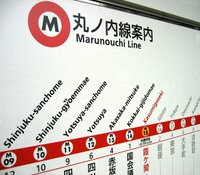 The subway line closest to my apartment is coded red. Inspiration met originality – I would be the Marunouchi Line, Tokyo’s second oldest and my second most disliked after the Ginza Line. Sometimes it’s so crowded that I miss my stop because I can’t fight my way out fast enough. Carriages that smell like the men’s bathroom don’t add appeal.
The subway line closest to my apartment is coded red. Inspiration met originality – I would be the Marunouchi Line, Tokyo’s second oldest and my second most disliked after the Ginza Line. Sometimes it’s so crowded that I miss my stop because I can’t fight my way out fast enough. Carriages that smell like the men’s bathroom don’t add appeal.
After working a thankless 13 consecutive days at school, I was ready for a holiday, any holiday. The Halloween dance card was full: four parties in one night. The first required no invitation.
In the same vein as a flash mob, an expat Halloween tradition calls for a costumed convergence on platform 13 at JR Shinjuku station, the busiest in the world. Here we would catch (commandeer) a Yamanote line train. With 3.55 million riders daily, this line is the bread and butter of Tokyo mass transit. Famous for its light green color and cattle cars where the seats fold up during rush hour, Yamanote trains endlessly circle the core of Tokyo connecting the city’s major transit hubs.
Dressing in red wouldn’t be clear enough, so I spent two hours fashioning the Japanese for “Marunouchi Line” onto the back of my red track jacket. It’s the first and last time I’ll ever write kanji, but the result was striking. Two letter “M”s taped on the butt and thigh of matching sweatpants completed the look. 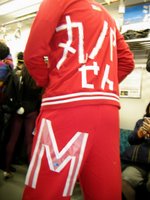 From the front, I looked like a bad 80s rapper. From the back, I was more puzzling. Who would embody a subway line? Again, Halloween is not a well-known concept here, so I simply looked freakish from every angle. Stepping outdoors, I quickly retreated back in – to a convenience store to pick up two canned cocktails (7%) to calm my nerves on the way to platform 13. I got the rare-bird-escaped-from-the-zoo look. Tropical plumage from head-to-toe was a magnet for attention. I became sensitive to sounds. Even busses rumbled by with laughter.
From the front, I looked like a bad 80s rapper. From the back, I was more puzzling. Who would embody a subway line? Again, Halloween is not a well-known concept here, so I simply looked freakish from every angle. Stepping outdoors, I quickly retreated back in – to a convenience store to pick up two canned cocktails (7%) to calm my nerves on the way to platform 13. I got the rare-bird-escaped-from-the-zoo look. Tropical plumage from head-to-toe was a magnet for attention. I became sensitive to sounds. Even busses rumbled by with laughter.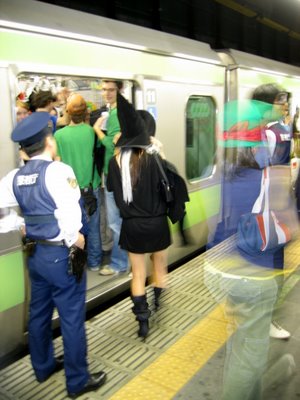 Powerless police officers puttered about platform 13, whispering distress into their radios. Open containers, however, were legal. And so were we, just waiting for the train.
Powerless police officers puttered about platform 13, whispering distress into their radios. Open containers, however, were legal. And so were we, just waiting for the train.
The 21:07 to be exact. That was the pre-decided time to ride. I stepped on the yellow line, and aimed my camera at headlights growing in the dark. The conductor, aware of who awaited, put some serious juice on the horn as the train blew into the station. The crowd cheered. It was party time.
Without enough crazy foreigners to take over ten cars, only the last was targeted. Passengers were given the courtesy of exiting before the spirits of the night stormed the carriage to rile up the unlucky remaining ones. One Japanese woman, coincidentally in an orange sweater, looked like she had seen a ghost, so to speak. The doors closed, the gears wheezed, and we cracked open beverages and yelled “kanpai!” to toast our departure.
Shin-Okubo…Takadanobaba…Mejiro. Locals left and those in costume consolidated control of the car. At each station, boarding passengers received a rowdy welcome, whereupon they scrambled up the platform to find a tamer car. As usual, many commuters waited at Ikebukuro station (change here for the Marunouchi Line). They froze on the platform. The next train was only five minutes behind.
The mood inside was festive, but there’s really only so much fun you can have drinking aboard mass transit. The Yamanote loop takes about an hour, but my next party started in half that time, so I jumped train at Komagome station to retrace my tracks back towards Shinjuku.
According to someone who saw the evening news, foreigners were blamed for causing delays on the line because at each stop revelers would dance on the platform right through the closing door melody and jump back on in the nick of time (see footage below).
For more, check out these Youtube highlights. I guess I exited too early cause it looks like they had a lot more fun than I had.
My friend Delphine, uncostumed but accompanied by a Columbian suitor, also reversed course. Pabo seemed a little spooky himself, a hunch that she confirmed at lunch the next day. Apparently he had a thing for the French damsel, which he subtly conveyed by trying to force her hand down his pants to prove just how small it was. Over instant messenger he once sent her an unsolicited picture of his toothpick.
“He goes on three or four dates a week,” Delphine said. “And he takes girls to love hotels and films it. He’s showed me. ‘It’s small, isn’t it?’ he asks me.” Delphine said that while he’s kooky, he’s no liar.
After Maria’s birthday and Halloween party in Shibuya, I cabbed it to DJ’s place. Rain began to peel away my letters, so I skipped the fourth party to crawl home to bed.
Meeting up with Delphine for lunch the next day, she took one look at my clothing and said with a smirk, “I like you in red better.”
* * *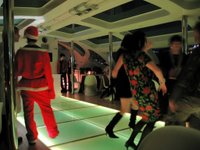 A week later was Jackson’s birthday, which he rolled into a post-Halloween bash on a boat cruising around Tokyo Bay. Ever the crazy Canadian, I like Jackson because he’s that guy. Check him out here lounging on the Yamanote line’s luggage racks.
A week later was Jackson’s birthday, which he rolled into a post-Halloween bash on a boat cruising around Tokyo Bay. Ever the crazy Canadian, I like Jackson because he’s that guy. Check him out here lounging on the Yamanote line’s luggage racks.
Once again I dressed up in the color of embarrassment. Halloween was so last week, I thought. No sooner had I locked my door than I heard English voices echoing down the corridor. Crap! It’s my neighbor Mike whose name I’ve seen on the mailbox but hadn’t met in person. He and three friends turned the corner before I could unlock the deadbolt and hide inside.
“Uhh, hi?” I said, clutching my keys.
“Hi, I’m your neighbor” Mike said, doing his best to act casual.
“I don’t usually dress like this, I swear.”
“You’ve got a party to go to, I see,” a friend said.
“Yeah, it’s a post-Halloween thing. I know it’s over, but….”
“Hey, it’s been happening all week,” the friend said, bailing me out.
To get to the pier, I caught a ride on what else but the Marunouchi Line. On the platform, a Japanese man came up to shake my hand and call me a “cool guy.” I felt like a traitor transferring to the Ginza Line, where a drunken salaryman also stopped to shake my hand with a giggle, but fortunately not a grope.
Party pictures can be viewed here.

Posted by
ジェフリー
at
12:00 PM
0
comments
![]()
Labels: social, transportation
Sunday, November 12, 2006
Train Bingo
How well do you know your fellow commuters? Play the game and find out. I'm behind the concept and text. My co-worker labored on the illustrations. Disclaimer: some squares may only apply in Japan. Click to enlarge.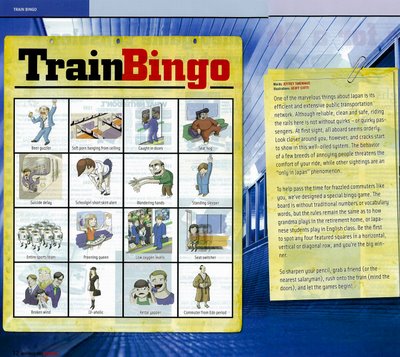
Posted by
ジェフリー
at
8:45 AM
2
comments
![]()
Labels: Tokyo, transportation
Thursday, November 02, 2006
Pinch Hitting
Teaching intractable junior high kids without basic English skills, I’ve often wondered what it would be like to take on elementary school ones rawer in behavior and ability. In February I found out.
Subbing in the suburb of Funabashi required a 5:40 a.m. wake up call. That was the easy part. To earn some extra income east of Tokyo, I had to transfer from the safety of a train with English signage to the unpredictability of a Japanese-only bus.
Figuring out the right stop was like solving a math problem with only two known variables: travel time from the station depot and the cost of the journey, which every now and then increased with distance. The kanji of stop names flashed up on the screen like scrambled squiggles, and I couldn’t catch the driver’s announcements. A wrong guess would leave me, the functional illiterate, late for school and freezing alongside unknown empty fields.
Students of this elementary school (where I arrived on time) had one 20-minute English lesson per week. That’s in addition to their Spanish class. Two things struck me about the English classroom: no chairs and no board. Before I could reformulate my lesson plan, by twos in marched the first class – seven-year-olds with mucus-streaked cheeks and curious eyes fixed on the giant white alien. I stared at them, and they stared at me.
Nametags dangled from their necks, and one began whimpering about something. Others intently picked their noses or smiled with mouths full of misaligned teeth. I was not accustomed to students out of uniform. Their hodgepodge sweatshirts and overalls included mangled phrases like “Life Is Like A Music” and “Somewhere I Have Never Been. Sometimes I Am.” Yet their clothing was as colorful as their eyes were warm. They were clearly surprised to see a new teacher half the age and weight of their regular Tuesday instructor.
The great thing about elementary school is that it’s game time all the time. Their cooperation and enthusiasm put my junior high misfits to shame. We first reviewed vegetables by splitting into small groups and playing memory with flash cards. No blackboard was necessary because they couldn’t read English let alone much kanji (just like their subbing sensei). So they memorized English words based on picture associations. Spinach, sweet potato, and spring onion, their vocabulary made me hungry for lunch until I thought I heard them recite “toilet paper” when holding up a picture of a bell pepper.
“Stormy Night” played over the PA during lunch. When nobody in the teacher’s room noticed that the song got stuck, I politely pointed to the ceiling speaker and then to my ear while bowing my head with a smile.
With winter approaching again, I think back to that cold day in a new place. Inside, the miso soup for lunch and extra servings of smiles warmed me up. Just a one-day job, by the end it was still hard to say sayonara. The little buggers tagged along in the corridor as I walked to the stairs leading down to the entrance.
Changing into my outdoor shoes, I heard footsteps and looked up. An Adidas tracksuit bounded downstairs to send me off with a hug. I gave the boy a final sayonara, and made my way to the bus stop.
Outside, the sidewalk abutted the playground where recess was in full swing. Two girls kicked up dirt while balancing giant orange cones on their heads. Then I spotted the tracksuit jumping off the jungle gym. The next thing I knew, the boy slid through the gate. He attached himself to my leg and wouldn’t let go. I forget what I said to him in Japanese, but I’ll always remember that firm grip of appreciation.
Posted by
ジェフリー
at
4:33 AM
1 comments
![]()
Labels: teaching (general)
Monday, October 23, 2006
Spiritual Natadera
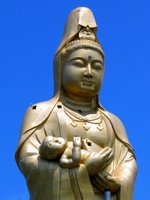 Riding a newfound Buddhist kick, I was lured to the rocky caves of Natadera (那谷寺) after seeing a dreamily landscaped picture while in the Kanazawa tourist office. For a day trip, I headed west to Kaga Onsen station, where I disembarked, looked up, and saw a white elephant towering above the trees. Upon closer inspection, it was neither white nor an elephant, but rather golden and a mutant cross of the Virgin Mary and Buddha. At the risk of sounding blasphemous (all sanctity was lost after The Grope), what the hell is this thing?
Riding a newfound Buddhist kick, I was lured to the rocky caves of Natadera (那谷寺) after seeing a dreamily landscaped picture while in the Kanazawa tourist office. For a day trip, I headed west to Kaga Onsen station, where I disembarked, looked up, and saw a white elephant towering above the trees. Upon closer inspection, it was neither white nor an elephant, but rather golden and a mutant cross of the Virgin Mary and Buddha. At the risk of sounding blasphemous (all sanctity was lost after The Grope), what the hell is this thing?
No such iconic tawdriness existed on the forested grounds of Natadera, a temple of the Shingoh Sect of Buddhism. Founded by monk Taicho in 717 A.D., this sanctuary continues to harmonize humans and nature through religion. It was refreshing to have spirituality and the environment overshadow man in Japan, a capitalistic country paved over in asphalt and coated in concrete. 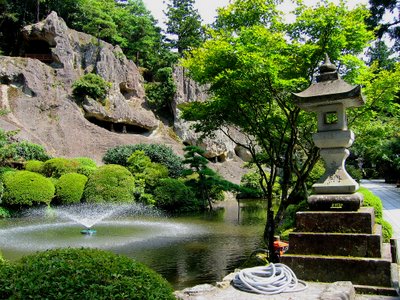
For a closer look at some greenery, view my pictures here. Click on images to read descriptions.
Posted by
ジェフリー
at
11:11 AM
0
comments
![]()
Labels: domestic travel
Wednesday, October 04, 2006
Kanazawa: Marsh of Gold
 On paper, Kanazawa (金沢) had all of the traditional trappings that foreigners associate with Japan: geisha districts, samurai villas, meticulous gardens, a castle, and a ninja temple.
On paper, Kanazawa (金沢) had all of the traditional trappings that foreigners associate with Japan: geisha districts, samurai villas, meticulous gardens, a castle, and a ninja temple.
After a seven-hour coach ride from Tokyo, the capital of Ishikawa Prefecture greeted me as it does most travelers: with a downpour. Rain-streaked windows blurred my first views of a city where Hideki Matsui played high school ball. Kanazawa averages 178 days of precipitation a year, so it’s fitting that the train and bus transit hub is designed like an open umbrella.
Once the weather cleared, I set out along doublewide sidewalks with far fewer pedestrians than in Tokyo, whose steamy asphalt I had escaped for four relaxing days. For an ambitious walker like myself, Kanazawa’s well-labeled sites (in English!) are navigable by foot. And unlike in Tokyo, shady benches are on hand to spell your feet.
Parks, gardens, and sculptures give the city a pleasantly landscaped feel that’s lacking in Tokyo. Kenrokuen Garden (兼六園) is known to be Japan’s finest, and if the crowds are any indication, it’s true. The “garden with six sublimities” opened to the public in 1874; in 1922, it was designated as a National Site of Scenic Beauty. In 1985, it was designated as a National Site of Special Scenic Beauty. I’m not sure what the difference is, or why that took 63 years to designate.
What a recently recreated castle lacked in historic charm, the surrounding park made up for in beauty with rolling lawns and flowerbeds that contrasted to cloud-white castle walls seemingly floating in the blue sky.
My favorite part of Kanazawa was exploring temples clustered at the base of Mt. Utatsu. After walking through the Higashi Chaya Geisha District – the best of the three in town – I wandered along winding lanes of a residential neighborhood where I had the streets and temples all to myself. It was tempting to get lost, but even cemeteries hidden in the woods had directional signs in English.
Of all of Japan’s temples and shrines, Myoryuji was by far the most memorable. Erroneously dubbed “ninja-dera” (ninja temple), no agents of assassination and espionage ever inhabited these grounds, yet the crafty layout would sure make them proud. The building appears to be two stories from the outside, but like most things at Myoryuji, appearances are deceiving.
The inside revealed four stories (or seven levels, counting mezzanines) with no fewer than 29 staircases. Plenty of contraptions baffled intruders and probably the Kaga clan who used the building in Edo times. Trap stairs, a fake offertory box in the floor, and a kitchen well rumored to link to a tunnel leading to the castle kept past enemies and present tourists ever guessing.
Far more confusing, however, was a Noh performance later that evening. Kanazawa specializes in one of the five schools of this traditional drama popular during the 17th-19th centuries. Reputedly one of the most boring performing arts ever known to man (at least those from Western countries), the drama made me wish I had brought toothpicks to prop my eyelids open.
The lone actor’s subtle gestures and lyricism went right over my sleeping head. In the first of two acts, a man in baggy, old school attire paced around the stage while taking his pointy straw hat on and off. Occasionally he let out haunting laughs. Action climaxed when he threw the hat on the stage and stomped off stage right. Rousing applause.
Even Japanese kids held their heads up better than the only foreigner in attendance. Nevertheless, I found it a relaxing way to spend $10 and an hour and a half. It was sort of like going to the opera, where I also can’t understand anything, but the rhythmic tones therapeutically clear my mind.  To that end, a Kanazawa retreat comes highly recommended to anyone in Japan needing a change of scenery or recharge of batteries. Check out the rest of my pictures here.
To that end, a Kanazawa retreat comes highly recommended to anyone in Japan needing a change of scenery or recharge of batteries. Check out the rest of my pictures here.
Posted by
ジェフリー
at
6:00 AM
0
comments
![]()
Labels: domestic travel
Thursday, September 28, 2006
Sayonara to Summer
In half an hour? The Japanese aren’t known for their spontaneity, but here Kensuke was inviting me to a BBQ two days after he saved my life. It was the last day of summer before I returned to work. Soon I would only be able to feel the sunshine from the wrong side of classroom windows.
The night we met at DJ’s place, Kensuke mentioned his favorite park near where we live. I counted the homeless people sleeping on benches in Yotsuya Sannencho Park. No sign of grills. No sign of him either.
Once he arrived at our designated meeting point, he led me away through twisting alleys with quiet homes bathed in soft afternoon light. A park like none I have seen in the capital came into view. A bamboo fence enclosed a gravel lot. In one corner, trees shaded a small shrine. Businessmen and elementary school children stopped by to summon the spirits.
Dark splotches dotted the back of Kensuke’s Bob Marley t-shirt. A towel wrapped around his neck soaked up the last of summer’s sweat. Our feet crunched on pebbles as we approached his four friends sitting around a hibachi. Two sat leaning against the fence sharing earphones like Siamese twins.
The cook rose up from sitting on the cooler to welcome me with a cold Yebisu beer. I recognized the tanned and mustached boy from DJ’s place. The grill sizzled with an assortment of meat, which he piled generously onto my paper plate before I took a “padded” seat on a flattened cardboard box.
This being a city that has repeatedly burned down over its long, fire-prone history, cooking devices were banned in the park. Helicopters chattering above added to the cook’s paranoia, which he voiced in Japanese.
“If the police come, you run,” translated a slim 19-year-old who has the Friday night shift at Kensuke’s restaurant. He pulled back his long auburn hair with a tortoiseshell headband and continued, “You are teacher.”
We all laughed. Water sources close at hand quelled any risk of fire. Near the shrine was a manual water pump, and much of this small sanctuary was filled with a dirty pond home to some resilient goldfish and one fearsome Kappa water monster, or so the boys told me.
This mythical creature lurks in rivers and ponds, and preys upon humans by gently sucking out their entrails through the anus (distended rectums of drowning victims is evidence). Only cucumbers can combat a Kappa’s hunger for humans, so pocket a good supply the next time you take a dip.
The hot plate sizzled with pork, sausages, smelt fish, and veggies. A record player studded with Sapporo bottle caps turned out reggae beats. I held my own as we talked in Japanese about various subjects like music, cars, and girls. They said Japanese Olympic gold medal skater Arakawa had a “horror face.” I charged that American Britney Spears was dumb and ugly. However, we came to agreement that Sharapova was one fine piece of Russian meat.
Aside from the imported Jamaican music, the park, food, company, and conversation felt like the real Japan. Although always an outsider here, for a few hours on the last day of summer I felt incorporated into Japanese life.
It didn’t last long. I suddenly urged to cry out in my native language. Surrounded by the Japanese atmosphere, I wanted to reassert my identity. I grabbed my Yebisu beer can, and thumbed away the beaded sweat. I read the English label aloud like I was at a poetry reading. Even the earphone twins tuned in to listen. Unable to digest my words, they captively swallowed them whole.
“You are so cool,” the cook smiled following my impassioned delivery.
I took a refreshing sip before returning the compliment with an empty plate.
Posted by
ジェフリー
at
7:45 AM
0
comments
![]()
Wednesday, September 20, 2006
Gossiping with a View
Five months had passed since we last screamed at infamous Kanokita School kids together. It was time for a reunion. Ms. Hattori, who was last seen on the blog changing classroom tactics, invited me to dinner and drinks on the 24th floor of a hotel overlooking drab suburbs receeding north of Tokyo.
She showed up in a black suit, and I in a short-sleeve shirt and hiking pants, which didn’t seem to faze the tuxedoed servers. I also came with an appetite for all-you-can-stomach appetizers and drinks. Ms. Hattori came with a stack of 300 loose photos from her summer vacation trip. Seeking school gossip rather than a slideshow, I suggested that we look at them later over coffee, hoping that moment would never come.
Photos or not, she couldn’t tell me enough about the Australian way of life during her homestay in Carins where she brushed up on English and volunteered at some schools.
“Do you know Holiday Inn?” she asked like it was the holy grail of hotels. I nodded. “I ate seafood buffet at Holiday Inn. It was dericious!”
Armed with glossy illustrations, out came pictures of platefuls of half-eaten food (one for every dinner down under), the airport tarmac, bus stops without timetables, a park bench. My favorite was of her with her fleshy host mother posing on red satin sheets. I slugged back another Moscow Mule (quite refreshing in the summer heat), and excused myself to the sushi platter.
With my chopsticks around some squid, she leaned over and told me that I couldn’t tell anyone. About what, feeding peacocks in the host family’s backyard? No, about her entire trip. This wasn’t an ordinary summer vacation. It was a guarded secret that only the principal knew. Apparently Kanokita had taken its toll on the green teacher. Those kids could drive anyone to an early retirement. She flipped open her phone and showed me a picture.
“Looks like confetti on the floor,” I said.
“That’s my worksheet!” she cried.
Ahh, how I miss those kids. Well, she didn’t, and instead of a recommended week of stress therapy in the hospital, she fanagled four in Oz.
Despite the respite from work, she was full of school news. First the good: Kanokita captured the Tokyo tennis title. The young Omiyada “handicapped class” teacher I played basketball with got married. A shotgun wedding was rumored.
Then the bad: one of the 9th graders stole a bicycle. Others were caught smoking on the top floor, having broken a wall and set something on fire. That both the fire and police departments responded was apparently a bigger deal than just the usual visit from Tonka toy-like fire engines.
And last, the ugly: April’s test results were in for Tokyo’s junior high schools. Kanokita ranked last – in the ward, and in the entire city. The average school scored a 70. Kanokika’s rowdy neighbor Nakamizu placed second to last in the ward with a 34. Kanokita scratched out a 30, the lowest of anywhere in the world’s largest metropolis.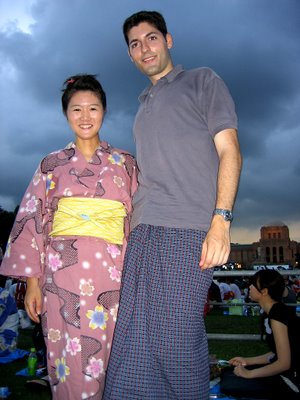 The news was confirmed a week later at a fireworks display. For the festival, Ms. Hattori wore her summer yukata, and I wrapped myself in a Burmese longyi, which got more than a few stares on the subway ride over. As fireworks exploded overhead, Ms. Hattori’s friend, an English teacher at Nakamizu said how demoralized her school felt about coming in last.
The news was confirmed a week later at a fireworks display. For the festival, Ms. Hattori wore her summer yukata, and I wrapped myself in a Burmese longyi, which got more than a few stares on the subway ride over. As fireworks exploded overhead, Ms. Hattori’s friend, an English teacher at Nakamizu said how demoralized her school felt about coming in last.
“But you weren’t last,” I pointed out.
“Well, everyone knows that Kanokita is the worst, so they don’t really count.”
Worst or first, those mischievous kids remain close to my heart.
Posted by
ジェフリー
at
10:47 AM
3
comments
![]()
Monday, September 11, 2006
The Night Kensuke Saved My Life
 DJ’s party is always a good place to meet Japanese people. Last month’s theme was “virgin honeymoon,” and featured a mural of a pumpkin-headed woman in a mini-skirt swinging an ax. Illuminated under black lights, it came closer to Halloween than honeymoon.
DJ’s party is always a good place to meet Japanese people. Last month’s theme was “virgin honeymoon,” and featured a mural of a pumpkin-headed woman in a mini-skirt swinging an ax. Illuminated under black lights, it came closer to Halloween than honeymoon.
Unlike past events when I helped pass out flyers on the corner to suspected English-speakers, this party was a closed event. The bar was trying to keep a low profile – from the cops. Apparently they had visited on another night, which was enough to spook DJ & Co. of a follow-up at their monthly event.
Usually I don’t have a connection to the people I meet, but I shared something in common with Kensuke. He lives down the road from me, and works at an izakaya in between our apartments. He invited me for dinner two nights later.
Wisps of a goatee decorated his young face. Soft, wide almond eyes invited friendship. He seemed like the sort of person you could become friends with instantly. He dressed like an apprentice in the restaurant’s t-shirt and a tightly rolled headband that crowned his head like a halo. He accompanied the chef on frequent smoking breaks in the kitchen. In 35 years I could see him in the chef’s grease-stained apron with the frying pan in one hand and a cigarette in the other.
The chef, 59 and grandfatherly, spoke just a few words of English, so we stuck to basic Japanese. Not knowing what to order, I expressed basic preferences, namely that “I like fish and meat.” He took it from there. The boiled and bony mystery fish was disappointing, but five assorted yakitori skewers made up for it.
Kensuke brought me a raw egg to use as a dipping sauce for the meat. Raw eggs are a common and flavorful garnish in Japan. I draw the line at eating raw chicken. Away I dipped, only to have Kensuke correct me that only one of the five skewered meats was meant to be egged.
Three hours of limited Japanese conversation ensued. Kensuke asked if I wanted to finish off my meal with some sake. It went down smoother than water. The chef scolded him upon learning that he had poured from the most expensive bottle. Master wrote it off on the house.
The owner of the restaurant had one more present before I called it a night. Master reminded me of someone who would have attended Woodstock. Concert posters, t-shirts, and autographed photos lined the walls. A long, bony face sat atop a lollipop frame. A rolled-up headband also circled his head, and his lips squeezed a lit cigarette.
From a box of individually wrapped sweets, he presented me with a pastry from Sendai. He had trouble opening the plastic wrapping. At a BBQ the next day, Kensuke would tell me that Master was roaring drunk as per usual, although he hid it well. He sliced through the wrapping with scissors, and put the pastry on a plate in front of me. He turned his attention to a small packet that came wrapped with the pastry.
Master’s fingers obstructed my view, but I was pretty sure it was a dessicant, boldly labeled “DO NOT EAT” in both languages. Master cut it open.
“Excuse me, what is that?” I quivered in Japanese.
“Sauce,” he said, dumping black powder onto my white pastry. I cringed. The powder looked like mold, and had some seasame seeds mixed in. Was he trying to kill me? I hadn’t even paid the bill yet.
Although still very much a foreigner, I now see through Japanese eyes. Master’s pastry put me in a pickle. I thanked him for his generosity, and prepared to save face by stuffing mine. My gut churned at what a sense of cultural dignity moved me to eat. I could stomach the aches. Besides, I was still on summer vacation, and had a free day to burn at the doctor’s or hospital if necessary.
I stalled by nusing the last of my sake. I trusted its guidance. I reasoned turning the pastry over and picking at the untainted side, and conceding fullness before I fully poisoned myself.
My hand hovered above the plate. Just then Kensuke came out of the kitchen. He was holding the crumpled packed Master had thrown away. He politely suggested to his boss that maybe the special sauce wasn’t designed for digestion.
“Hai, hai, hai,” Master chuckled off the minor mistake, slapping me on the back. He staggered to the back of the room to fix me up with a pristine pastry.
I turned to Kensuke and mouthed thanks. The incident shook me up, not because of Master’s mistake, but at how I had nearly convinced myself to nibble around poisoned food to maintain the important Japanese concept of harmony.
Master and chef bid me farewell, encouraging me to return again. Thanks to a life-saver named Kensuke, I intend to do just that.
Posted by
ジェフリー
at
9:39 PM
1 comments
![]()
Thursday, September 07, 2006
Saw Mountain

There’s something about seeing Buddha that always puts me in a good mood. Maybe it’s his restful pose, assuring gesture, or level mind free from desire. Whatever it is, he makes for a good role model if there ever was one.
Although Japan’s population is 84 percent Shinto/Buddhist, it’s a secular society. So unlike other Asian nations, Buddhas are few and far between the massive department and electronic store temples enshrining Japan’s dominant consumer culture. Of Japan’s two famous Buddhas, I already made a pilgrimage to Kotoku-in in Kamakura. Todai-ji’s Buddha in the ancient capital of Nara is even larger (60 feet). I will pay respects later this month when my parents visit.
Rising more than 100 feet is Japan’s largest daibutsu, yet also its most obscure (unreferenced in Let’s Go). Nihon-ji temple dates from 725 A.D., but its Buddha arrived 1,058 years later. This stone beheamouth sits about halfway up Nokogiri-yama, or “Saw Mountain,” so called because it’s shaped like the teeth of a saw thanks to bygone quarries chipping chunks out of the mountain’s face.
The mountain is only 329 meters (1079 feet) high. Getting up took a few minutes in a cable car. Getting there took three hours. To halve my transportation costs, I opted for local trains that required four transfers, one taking an unprecedented 45 minutes (I’ve never had to wait that long for a train here). My destination was worth the wait.  Cool mountain air whisked away sweat as I soaked up panoramic views of Tokyo Bay. Hawks soared overhead in cloudless skies. Sunlight percolating through the leaves lit shady footpaths. I walked alone along mountainside paths, but 1,500 stone arhat figurines (novice buddhas) – each said to have a different expression – kept me company. They were wedged into rocky ledges and perched on trees. Moss, lichen, and faith held them in place. If I had to be a statue (and hopefully not one of the headless variety), this would be where I’d want to sit gathering moss.
Cool mountain air whisked away sweat as I soaked up panoramic views of Tokyo Bay. Hawks soared overhead in cloudless skies. Sunlight percolating through the leaves lit shady footpaths. I walked alone along mountainside paths, but 1,500 stone arhat figurines (novice buddhas) – each said to have a different expression – kept me company. They were wedged into rocky ledges and perched on trees. Moss, lichen, and faith held them in place. If I had to be a statue (and hopefully not one of the headless variety), this would be where I’d want to sit gathering moss.  Later I found another Buddha-like icon carved into the mountain. A 30-foot high image of Kannon, the Buddhist Goddess of Mercy, towered from within an alcove. Dating from the 1960s, however, it’s a recent addition to the mountain’s attractions.
Later I found another Buddha-like icon carved into the mountain. A 30-foot high image of Kannon, the Buddhist Goddess of Mercy, towered from within an alcove. Dating from the 1960s, however, it’s a recent addition to the mountain’s attractions.
Under the watchful gazes of Buddha and Kannon, I paused for water and to reflect on life. Around 4:30 I climbed down the mountain and happened upon a beach. I stopped first at a 7-11 for dinner: soba noodles, a riceball, and a “freeze lemon -196C” chu-hai (canned cocktail). You know, just the essentials. I sat and sipped on the beach as daylight departed. It wasn’t Thailand, but it wasn’t Tokyo either, and that’s all that mattered.
Click here for more scenes from Nokogiri-yama.
Posted by
ジェフリー
at
10:10 AM
0
comments
![]()
Labels: domestic travel
Thursday, August 31, 2006
Onna Hirona
I’m glad August is over. It’s just not my month. Last August, Krazy Katherine (a.k.a. India Girl, where I had met her on vacation) descended upon Tokyo for what would be my most unpleasant week that year. You won’t find a blog about it. I tend not to write about romance or disaster. But just days after I wrote about both, my heart would ache again. I figured the best way to forget about dating disaster girl would be to hit the clubs and find a new onna, or woman.
Hirona and I had made eye contact earlier, so I moved in when I saw an open seat on the couch next to her. Her friend was passing out on a pile of bags on the other side. I know enough Japanese for the first three minutes of any conversation, but I quickly reverted to English to verify what I thought I heard.
When she said she lived in Omiya (50 minutes north of central Tokyo), I added that’s not far from where I teach. Then she said the name of her former high school. It sounded familiar. It was my school! She woke up her friend and former classmate to share the news. His English was good, too. I speak with authority when I say they that didn’t learn it in high school. We both graduated in 1998, but it seems like some old timers have been teaching since the school’s inception in 1947 (and dressing like it, too). We played the “do you know so-and-so sensei?” game, and one rang a bell.
“Hey, do you still have your school uniform?” I suddenly asked.
She looked at me and smiled. Then I looked down and frowned. What kind of perverted question was that? I’m not into that. I mean, I’m a teacher. I can’t be into that.
“You must be very popular at school,” she said.
“Well, sort of. With the high school girls a little bit. But my junior high kids could care less about me. In fact, a few girls openly dislike me.”
I told her she should come for a reunion. Then I had a better (read: worse) idea. Displaying affection at school is strictly forbidden. In fact, displaying affection anywhere while in uniform is strictly forbidden. Last year two junior high students were suspended because they were seen touching lips in town.
“On the last day, I want to kiss you in the middle of the courtyard at school,” I said. “Bring your friend, too.” It would be a legendary sayonara moment, and the final affront to what has been a less than pleasurable teaching experience.
Wanting to speed up that moment, we danced with the help of several gin and tonics. Things got a little blurry. She kept checking on her friend. And I kept loosing her in the dark crowd until I thought they had left.
I flipped open my phone and scrolled to “H.” Hidomi…Hika…Hillary…Hiro…Hirona (X). I use that designation to remind myself never to call someone with whom I politely traded numbers. But I was totally into Hirona. Then I remembered I had met a different Hirona earlier that night.
“You’re the most beautiful guy I’ve seen in Japan,” she had said at the bar. She obviously didn’t get out enough, so I walked away after she asked for my number.
I couldn’t believe that I had spent hours with the good Hirona and forgot to get her number. All I knew is the region where she lived. That gave me one chance. 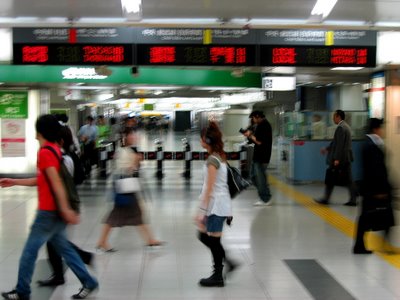 I pushed out of the club, and made a beeline to Shinjuku station. I bought a ticket for a train I would never take. The time printed on the stub was 04:45. I went up the platform, eerily silent and hazy just before sunup. It was still too early for service, but I wasn’t going anywhere for a while. I planted myself at the foot of the stairs to the two tracks with trains bound for Omiya. She would have to pass through here to get home, or so I hoped.
I pushed out of the club, and made a beeline to Shinjuku station. I bought a ticket for a train I would never take. The time printed on the stub was 04:45. I went up the platform, eerily silent and hazy just before sunup. It was still too early for service, but I wasn’t going anywhere for a while. I planted myself at the foot of the stairs to the two tracks with trains bound for Omiya. She would have to pass through here to get home, or so I hoped.
My phone buzzed with a message. It was Hirona. Hirona (X). I kicked myself, and maintained a vigil. The trickle of partygoers passing by went in and out of focus. I kept anticipating a purple and white striped shirt would come bouncing along. She was just a normal girl, nothing outstanding other than our high school connection, but the thought of another lost opportunity made me hold out hope. The odds of finding her in the world’s largest train station were slim to none, but that hadn’t stopped dating disaster girl’s ex-boyfriend from randomly spotting us together outside of it.  Two-toned pinging noises from the ticket turnstiles increased with frequency. The station gradually revved to life. Takao, 6:35, track 7. Utsunomiya, 6:42, track 4. Shin-Kiba, 6:44, track 5. Chiba, 6:51, track 11. Announcements flashed for trains fanning out from the world’s largest metropolis. At 7:00 I conceded defeat.
Two-toned pinging noises from the ticket turnstiles increased with frequency. The station gradually revved to life. Takao, 6:35, track 7. Utsunomiya, 6:42, track 4. Shin-Kiba, 6:44, track 5. Chiba, 6:51, track 11. Announcements flashed for trains fanning out from the world’s largest metropolis. At 7:00 I conceded defeat.
The station attendant looked at me. Yes, I had bought a ticket from the same station that I was now leaving. It was a long story, and didn’t feel like breaking out my survival Nihon-go and asking for “money, please.”
Walking home, I began murmuring the “Somewhere Out There” song. It had been playing in Jonathan’s restaurant (think Denny’s) where I had eaten alone just prior to clubbing. Alone again under the pale sunlight, the evening had come full circle.
Time to climb another mountain....
Posted by
ジェフリー
at
9:15 AM
2
comments
![]()
Labels: dating
Thursday, August 24, 2006
Mt. Mitake
 Continued from last post.
Continued from last post.
The next morning I awoke at 6 a.m. with a dry mouth and pounding headache. I had to get out of here. Anywhere but here. Fresh air would clear my mind, and hopefully erase last night’s episode.
An aging orange Chuo line train would lead me out of town. Actually, I technically wasn’t leaving metropolitan Tokyo, but was heading for a corner remote enough to wipe the bars off my cell phone.
I rode the train for two hours to the edge of my Japan Rail map. At Mitake Station I set out on a two-mile walk, some of it up a 15% grade. Nobody clued me into the bus service until it passed me. A six-minute cable car ride hoisted me up to 930 meters. After a 15-minute walk through a mountaintop village, I climbed 300 stairs to reach my destination: Musashi Mitake Shrine. A red X had replaced blue bars on my phone. I felt better already.
Here at this Edo-era shrine to the God of farming, I sat down and scribbled two pages of notes that evolved into the Dating Disaster blog. I capped the pen, and chugged a water. The cool mountain air buoyed my heavy heart. I had the day to myself, and was unreachable to the outside world.  Mount Mitake offered peace, quiet, and solitude. Although thanks to elementary school day-trippers, it was hard to feel alone. Packs of them in color-coded caps clambered up and down the stairs, pausing to raise thermoses of green tea to their lips.
Mount Mitake offered peace, quiet, and solitude. Although thanks to elementary school day-trippers, it was hard to feel alone. Packs of them in color-coded caps clambered up and down the stairs, pausing to raise thermoses of green tea to their lips.
I initiated konnichiwa greetings, and got high-pitched group responses. I’ll always remember the pudgy boy lagging behind. Sweat rolled off his face as he puttered down the stairs.
"Konnichiwa!” I said, breaking his concentration.
He looked up from the handrail and stared. “Who are you?” he sneered in Japanese. Kids are priceless.
The only good thing about the humidity was an excuse to spoon up kakigori, my favorite summertime treat. At a shop on the mountain I asked for green tea flavored shaved ice, which wasn’t on the menu. The only flavor I could make out was strawberry, so I settled for that. I relaxed at table with a panoramic view of the green valley below. I had just been hiking in the woods, where I sang to a captive audience of trees and rocks.
The friendly proprieter urged me to return again, and on my way out handed me seasonal brochures with the moutain ablaze in autum orange and spring’s pink cherry blossoms. So long as I don’t have any more dating disasters, I’ll relish this as my only visit.
For more scenes from Mitake-san, click here.
Posted by
ジェフリー
at
1:30 AM
0
comments
![]()
Labels: domestic travel
Friday, August 18, 2006
Dating Disaster
Wednesday couldn’t come fast enough. I had been waiting a week for dinner, over which time we had traded about 30 text messages. She was the perfect combination of lively, stylish, Japanese, proficient in English, and just a year younger.
Not yet hungry for dinner, we decided to get a drink first. The Hub, a British-style pub chain offered us a barrel to stand over in the middle of the smoking section. Hardly the right atmosphere. The next place sounded more promising. The only thing I could read on the sign for the fifth floor restaurant was “private dining,” written in English.
We checked our shoes at the door, walked past a waterfall, and then on top of a dry rock garden encased in glass. She did all of the ordering from our private booth.
My cell phone buzzed with a text message, but I didn’t budge. When hers buzzed, she looked. We chatted over beer while shelling wet peanuts (wet seems to be the custom here). She buzzed again, and typed back. Korean style pancakes arrived. She buzzed. Tuna and scallion maki rolls arrived. She excused herself. Fried cartilage came. I nibbled and waited.
When she returned, I remarked on the cartilage’s crunchiness as being kori-kori. She smiled and asked if I liked it, but didn’t hear my response. She was buzzing.
“Your friend?” I asked, forcing a smile.
“Yes,” she said while fiddling with her phone.
Perhaps something bad had happened. It had, but for me. In one of the busiest parts of a city home to of 32 million, somehow her Japanese ex of two years had spotted us together. He was mad, and letting her know about it. They had recently split, but not for much longer.
“You miss him?”
She took a sip, buzzed, and rose up clutching her phone. I stared at my beer. It was half empty. I have trouble finding my friends at a designated time and place, so how could this be? I’ve had chance encounters here before, but doesn’t this sort of thing only happen on TV dramas? A week’s worth of anticipation had evaporated within an hour. Just as I was about to reach for my wallet and leave ¥2000 ($17) on the table, she returned. We silently headed to get our shoes.
She removed my Pumas from the locker and arranged them on the floor. She turned to pay the bill – in its entirety.
“Gomen-ne,” she apologized.
I stood by the elevator waiting for her to get her shoes, also Puma.
“I’m going to the bathroom,” she said flatly. “Gomen-ne.”
I slammed the down arrow button. Outside, neon lights everywhere added to my shock. Cars, signs, vending machines. Everything was lit up and swirling in my mind. People rushed by from all directions. I didn’t know what to do with myself. Sitting on the sidewalk with a beer sounded good. Then I could roll into traffic.
Instead I walked home and had a second chance encounter. I bumped into Takahiro. His piercing feline eyes always make me feel uneasy. A tank top with the phrase “I’m not gay, but my boyfriend is” clung to his muscular chest. His shiny face reflected the neon lights. He has a plastic look, but is too young for cosmetic surgery. Jess once said that he was 24, but he looked older, perhaps because he had been playing the scene for too long.
Takahiro was pacing on the corner. Diego hadn’t arrived, and couldn’t be reached by phone. Diego had Taka’s esctacy and his money. I told him something bad had just happened to me.
“Ohhh, what’s wrong? Did you get AIDS?” he shrugged as if popping advil would do the trick. Takahiro has a great way of putting problems into perspective. After I told him of my heartbreak, he shared his dating news: yesterday afternoon he spent 12 hours banging the brains out of some German guy.
“But yesteday was Tuesday! Didn’t you have work?”
“It was my day off. I needed it. I was so tired from the weekend.”
He then gratuitiously recounted his clubbing-esctacy-meth-afterparty-sex-filled weekend. He flipped open his phone to show his conquests of chisled white men who could have walked out of a Calvin Klein ad. They were just from the weekend.
Was this supposed to be making me feel better? We ducked into the nearest bar for a beer and waited for Diego. Once the goods arrived, Takahiro dumped me. I walked the long way home.
* * *
“Go Tell It on the Mountain” is a gospel song. That Jesus Christ was born doesn’t have anything to do with my situation, but the title is fitting for how I coped the following day. Find out next week.
Posted by
ジェフリー
at
7:45 AM
2
comments
![]()
Labels: dating
Tuesday, August 08, 2006
Under the Bridge
My favorite place in Tokyo is not where you’d expect. It’s not in the shade of blooming sakura trees lining Ueno Park. It’s not atop the Mori Tower sky deck. Nor is it on the tranquil grounds of an Edo shrine. Rather, it sits unceremoniously in the shadows, below bustling Tokyo life.
My favorite place is underneath Ryogoku Junction overpass. Here, Expressways 9 (Mukojimasen) and 6 (Komatsugawasen) merge over the Sumida River as vehicles circulate into the beating heart of Tokyo.
The overpass marks the border of Koto and Sumida wards. Sky blue tarpaulins of displaced urban campers color the opposite bank, which lies in Chuo ward. This spot along the Sumidagawa terrace offers glimpses of mundane activities in three different wards at once. Here I reflect on my relationship to this dynamic city passing me by.
To be frank, the Sumidagawa is no Seine. Commercial barges traffic this working river with unremarkable views, but look into the murky water and the Sumida’s character will surface.
This corner of the river’s terrace is outfitted with child-size concrete stools encircling a round table. The shape reminds me of a small-scale Stonehenge tea party, without the teacups or bucolic English countryside. Instead, trucks rumble above, sounding off at the bottleneck traffic. An ambulance requests permission to pass (It’s Japan, of course they ask – and politely so). I gaze up at perfectly aligned rows of rivets in steely harmony with their surroundings. Water laps the expressway’s concrete pillars below. Beauty is in the eye of the beholder.
This is also the point on my jogging route where I pause before turning around. Shaded from the sun, I catch cross-breezes while stretching out my throbbing knees. I stop to survey the land and water, and the multi-colored bridges spanning the two. Pod-like water buses shuttle people between Asakusa and Odaiba. I wave to small pleasure craft operators or even the rare foolhardy jet skier. Activities under the bridge vary depending on the time and day. During the week, salarymen chow down on o-bento. Anglers cast lines. A retiree practices Tai Chi. A homeless man rests out the midday heat. An amateur artist paints watercolors worthy of framing. A woman strums a traditional string instrument.
Activities under the bridge vary depending on the time and day. During the week, salarymen chow down on o-bento. Anglers cast lines. A retiree practices Tai Chi. A homeless man rests out the midday heat. An amateur artist paints watercolors worthy of framing. A woman strums a traditional string instrument.
In the evening, couples pose for pictures as the sky glows orange. Under the cover of darkness youth ignite firecrackers, leaving charred remnants as evidence.
On warm weekends, the aging set in bucket hats and parasols stroll along the riverbank while shirtless men sunbathe on the benches. In winter, the homeless wrapped in blankets angle lounge chairs towards the sun. On Sunday, which seems to be designated dog-walking day, tiny pooches groomed to the teeth strut manicured paws and hair barrettes to owners parading their own canine pride. Wet noses rub; compliments are traded. I value the Sumidagawa terrace for its colorful touches, like graffiti, bridges, and blooming bushes. The terrace provides ample jogging space, sheltering me from hard stares I otherwise receive on narrow city sidewalks when darting around old ladies laden with groceries. This narrow patch of green and gravel disrupts the mismatched concrete blanketing Tokyo. A bamboo grove or mountaintop it’s not, but beneath Ryogoku Junction overpass is my choice for a Zen moment.
I value the Sumidagawa terrace for its colorful touches, like graffiti, bridges, and blooming bushes. The terrace provides ample jogging space, sheltering me from hard stares I otherwise receive on narrow city sidewalks when darting around old ladies laden with groceries. This narrow patch of green and gravel disrupts the mismatched concrete blanketing Tokyo. A bamboo grove or mountaintop it’s not, but beneath Ryogoku Junction overpass is my choice for a Zen moment.
Click here for a slideshow of scenes from the Sumidagawa.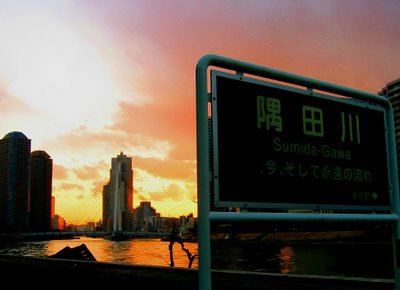
Posted by
ジェフリー
at
10:00 AM
0
comments
![]()
Labels: Tokyo
Tuesday, August 01, 2006
Animal, Vegetable or Mineral?
Making Sense of Japanese Supermarkets
I arrived in Tokyo from New York tired, alone, without a job and, worst of all, hungry. Eerily realistic plastic food displayed in restaurant windows wasn’t much help. I was clueless as to what the replica was imitating. Even picture menus puzzled. I needed someplace to inspect goods up close, and preferably under bright lights. I needed a supermarket.
Here, senses of smell, taste or touch come in handy when sight alone proves insufficient. Unable to crack Japanese labels, I play the grocery guessing game, which entails crossing fingers and tossing an item into my basket. I’ve made two memorable mistakes.
 I have an acute weakness for dried baby sardines inserted into Japanese snack mixes. True to my American roots, I buy in bulk. Elated upon discovering an extra large bag of little fish, I unwittingly purchased – and partially consumed – cat food, which got a rise out of a Japanese friend who declined a nibble.
I have an acute weakness for dried baby sardines inserted into Japanese snack mixes. True to my American roots, I buy in bulk. Elated upon discovering an extra large bag of little fish, I unwittingly purchased – and partially consumed – cat food, which got a rise out of a Japanese friend who declined a nibble.
I am also guilty of gulping what I thought was a can of refreshing “Italian lemon and California lime” soda. A few minutes later it hit me – in the head, as I stumbled around my apartment in a Suntory stupor.
A chore anywhere else in the world, grocery shopping in Japan transforms routine into cultural phenomenon. My local branch of the Akafudado chain is no exception. The experience begins right outside the supermarket’s automatic doors. A lady with a generous smile peddles a cart of ¥100 (85 cents) skewers of grilled animal parts unknown. Some are tasty, others crunchy. One triggered a gag reflex. Skewer lady competes with the singing meat display near the frozen food aisle inside. A portable stereo mimics the meat. It chirps at shoppers, “we like meat, take your pick” in a treble that only Alvin & The Chipmunks can match. One might expect higher prices and lack of music to drive skewer lady out of business. But jingles can backfire.
Skewer lady competes with the singing meat display near the frozen food aisle inside. A portable stereo mimics the meat. It chirps at shoppers, “we like meat, take your pick” in a treble that only Alvin & The Chipmunks can match. One might expect higher prices and lack of music to drive skewer lady out of business. But jingles can backfire.
The voices were cute, at first. But the tune turned repetitive, and then harassing. Now I restrain myself from gouging out eardrums with nearby toothpicks just to make the voices stop.
I take refuge out of earshot in the snack food section. Despite serving sizes fit for a gerbil, rice crackers, cookies and traditional sweets come individually wrapped within larger packages. It’s the equivalent of encasing each Dorito in plastic (which hasn’t been done here…yet). While the concern for freshness is admirable, the means to achieve it are an environmentalist’s nightmare.
Indeed, Japan is the land of small portions. Although now I’ve adjusted to thinking of their size as sensibly adequate, I used to eat at McDonald’s just to get enough calories. Sympathetic supermarket workers have taken notice.
“Delicious,” I said to one, satisfied after sampling his seafood salad. I reached for a container marked ¥462 ($4), but the employee pulled it out of my hands. He pried open the lid to slip in additional shrimp, jellyfish and cellophane noodles, but left the price sticker unchanged.
Another time, a young man at the gyoza station flagged me down for a taste test. After dishing out seconds, he directed my attention to baskets lined with clear plastic bags filled with what looked like melting intestines.  “Ika,” he said. It sure didn’t look like squid. He jabbed a toothpick into the basket brimming with pinkish worms, and extended the slimy offering. Although raw fish is a favorite food, even I paused at the sight of this freebie.
“Ika,” he said. It sure didn’t look like squid. He jabbed a toothpick into the basket brimming with pinkish worms, and extended the slimy offering. Although raw fish is a favorite food, even I paused at the sight of this freebie.
“Mexico,” he said, jiggling it. Mexican squid? What the hell, I thought, closing my eyes as it slithered onto my tongue and down the hatch. “Indonesia,” he pointed at the next basket. Just swallow, I told myself. “Japan,” he said with hometown pride, reaching for yet another toothpick. After cleansing the palate with some seaweed from Hokkaido, I thanked him for the world tour.
Free samples subsidize my strategy of eating supermarket cheap. Why pay more when you can’t afford it? Cutting costs on food in one of the world’s most expensive cities is a necessity. At Akafudado, I barrel down the aisles with Olympic athleticism in search of tofu, gyoza or anything left unwrapped. Insider’s tip: making a few rounds amounts to a free appetizer. I then head to the rear of the building (dangerously close to the singing meat) to select a bento box entrée. I regularly set my cell phone alarm to ring for 7 p.m. This begins the evening competition with salarymen and bargain-hunting biddies to snatch up marked down items. One reduced by ¥75 (65 cents) catches the eye. I never know quite what I’m buying, but bento beggars can’t be choosers.
I then head to the rear of the building (dangerously close to the singing meat) to select a bento box entrée. I regularly set my cell phone alarm to ring for 7 p.m. This begins the evening competition with salarymen and bargain-hunting biddies to snatch up marked down items. One reduced by ¥75 (65 cents) catches the eye. I never know quite what I’m buying, but bento beggars can’t be choosers.
While queuing for the register, people peer into my basket to see what the foreigner is feeding on for dinner. Doritos and Coke? On the contrary: bento, edamame, walnuts and sardine mix and a drink. I feel the urge to defend my strawberry milk selection by staring back and saying, “Yeah, well nice radish, lady!” It’s usually the thickness of my lower leg (or daikon ashi, but don’t say that “radish-legged” insult to a woman).
The checkout line gives me time to whip out my point card. It offers few financial rewards. Instead, the card confers status. I deliberately fiddle with it to advertise that I live here, too, and am not some stray tourist with the temerity to forage among the locals.  Arms saddled with plastic bags, I exit past the ¥290 ($2.50) apples. Murmurs of singing meat fade away. Skewer lady’s grill smokes as a customer looks on. Although often ignorant as to the species of mammal, vegetable or fish I’ve purchased, one thing’s for sure: grocery shopping in Japan sure works up an appetite.
Arms saddled with plastic bags, I exit past the ¥290 ($2.50) apples. Murmurs of singing meat fade away. Skewer lady’s grill smokes as a customer looks on. Although often ignorant as to the species of mammal, vegetable or fish I’ve purchased, one thing’s for sure: grocery shopping in Japan sure works up an appetite.
Posted by
ジェフリー
at
8:25 AM
0
comments
![]()
Labels: food
Thursday, July 27, 2006
Hey Mr. DJ
 Not one to turn down a party invitation, I met Yuji at the Roppongi station turnstiles. This area of town pulsates at night under neon signs advertising sweaty bars and decadent companion clubs. A haunt of tourists, expats, military and the Japanese who wanna party with them, I avoid Roppongi’s $9 beers and cheesy music at all costs.
Not one to turn down a party invitation, I met Yuji at the Roppongi station turnstiles. This area of town pulsates at night under neon signs advertising sweaty bars and decadent companion clubs. A haunt of tourists, expats, military and the Japanese who wanna party with them, I avoid Roppongi’s $9 beers and cheesy music at all costs. Yet Yuji’s friend was DJing, and I figured it would be a good chance to hang out outside of his father’s tiny restaurant where we had met. I’m glad I made the exception. Yuji’s limited English could not prepare me for what type of party to expect. To play it safe, I wore a button down shirt stuffed into slacks. I should have remembered that Japan doesn’t have a dress code.
Yet Yuji’s friend was DJing, and I figured it would be a good chance to hang out outside of his father’s tiny restaurant where we had met. I’m glad I made the exception. Yuji’s limited English could not prepare me for what type of party to expect. To play it safe, I wore a button down shirt stuffed into slacks. I should have remembered that Japan doesn’t have a dress code.  Yuji (right) – in baggy pants, a grey hooded sweatshirt and wool cap – led me in the opposite direction from the bright lights. We made a Family Mart run to grab drinks to finish off en route. The stairwell descending into the basement bar was dizzying. Graffiti lined the walls down to the bottom where a lanky DJ (center) welcomed me like an old friend, and handed out a CD with his R&B remixes.
Yuji (right) – in baggy pants, a grey hooded sweatshirt and wool cap – led me in the opposite direction from the bright lights. We made a Family Mart run to grab drinks to finish off en route. The stairwell descending into the basement bar was dizzying. Graffiti lined the walls down to the bottom where a lanky DJ (center) welcomed me like an old friend, and handed out a CD with his R&B remixes.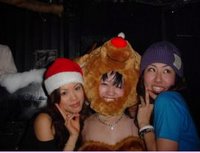 The bonenkai wasn’t starting for another half hour. This marvelous Japanese concept is known as “year-forgetting parties.” (This being back in December). Momo was already forgetting. He wobbled around the room in a large reindeer headgear. Yuji meanwhile posted flyers with the DJ lineup around the bar.
The bonenkai wasn’t starting for another half hour. This marvelous Japanese concept is known as “year-forgetting parties.” (This being back in December). Momo was already forgetting. He wobbled around the room in a large reindeer headgear. Yuji meanwhile posted flyers with the DJ lineup around the bar.
I was the only foreigner in attendance, which is how I like it. It feels more cultural in that lost in translation way. I get C-list celebrity attention, and don’t get annoyed with other foreigners who think they are god’s gift to Japan for being proficient in the language.
I did, however, feel conspicuously overdressed among the music video wannabes in oversized off-brand tracksuits, dangling chains and sunglasses – sometimes a sign of gang membership here. Then again, it’s hard to consider someone wearing size 28 pants as tough, especially with a Louis Vuitton wallet poking out of the back pocket. Sometimes they’d catch me staring with arced eyebrows at their outfits, but as a foreigner I can get away with it by falling outside of the Japanese social rubric. A smile and head nod turns embarrassment or confrontation into an icebreaker.
Sometimes they’d catch me staring with arced eyebrows at their outfits, but as a foreigner I can get away with it by falling outside of the Japanese social rubric. A smile and head nod turns embarrassment or confrontation into an icebreaker.
Such was the case with Kobe. I forget his real name, but he was wearing the basketball star’s jersey with matching Lakers cap and a fake gold chain that read “chain gang.” This Yokohama boy was no Bay Star. He looked the least likely of anyone in the room to play a sport or be in a gang. Yet he was eager to make my acquaintance, and summoned his friend Nao to join us.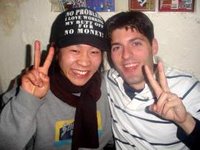 Long hair poked out of Nao’s trucker’s hat that read “No problem. I love working my butt off for no money.” His sweatshirt was two sizes too big, and he had a goofy grin like he had been sniffing too much glue. He was an older but just as immature version of my students. He even lived in the same neighborhood. Astonishingly, he too, had wandering hands. I’m beginning to think this is a latent cultural phenomenon.
Long hair poked out of Nao’s trucker’s hat that read “No problem. I love working my butt off for no money.” His sweatshirt was two sizes too big, and he had a goofy grin like he had been sniffing too much glue. He was an older but just as immature version of my students. He even lived in the same neighborhood. Astonishingly, he too, had wandering hands. I’m beginning to think this is a latent cultural phenomenon. Like most people I met that night, Nao had a curiosity for English. First about translations for private parts, and then about his hat. “Butt” was easy enough, but the expression wasn’t. What did working hard have to do with a butt? he wanted to know. Giving up in frustration, I asked to borrow the hat to wear to the next monthly teachers’ meeting.
Like most people I met that night, Nao had a curiosity for English. First about translations for private parts, and then about his hat. “Butt” was easy enough, but the expression wasn’t. What did working hard have to do with a butt? he wanted to know. Giving up in frustration, I asked to borrow the hat to wear to the next monthly teachers’ meeting.
I also had trouble translating “Shat,” the artist’s name on the flyer advertising the evening’s party. This being a country where M-Shit is a popular punk rocker (M stands for Mohawk. Shit, for talent).
Easier to explain was a baby blue Columbia varsity jacket, purchased second-hand and turning baby brown from a patchwork of stains. Kousuke was startled to learn that Columbia was a university in New York. I was startled to see it personalized with “Christie.”
Unable to translate songs titles like “Return of the Mack” and “Bug A Boo” or lyrics like “Can I have it like that?…You got it like that,” Nao suggested that we not pay bar prices and instead drink on the sidewalk outside Family Mart. While not illegal, it felt amateur…and freezing, this being winter.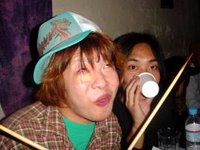 Back inside, Momo (right) was slumped over, naked without his headgear and neglecting the hot plate simmering with pre-cooked hot dogs on sticks for sale. More people had arrived, and Yuji facilitated introductions.
Back inside, Momo (right) was slumped over, naked without his headgear and neglecting the hot plate simmering with pre-cooked hot dogs on sticks for sale. More people had arrived, and Yuji facilitated introductions.
The underground setting bred intimacy. The vibe was friendship, not meat market, which is the selling point of foreigner hangouts in nearby Roppongi. Everyone seemed to know one another like we were in a party in a friend’s basement party. 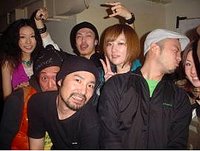 The dance floor got crowded. Passionate DJs moved their friends with homespun music. In typical Japanese style, no one was going overboard. No bumping ‘n’ grinding, just bopping in place. Fly swatter-like arm extensions towards the DJ signaled approval. Some added their own beat with two drums on hand for audience participation.
The dance floor got crowded. Passionate DJs moved their friends with homespun music. In typical Japanese style, no one was going overboard. No bumping ‘n’ grinding, just bopping in place. Fly swatter-like arm extensions towards the DJ signaled approval. Some added their own beat with two drums on hand for audience participation.
In between DJ sets, live acts took the stage. Japanese rappers wearing puffy jackets and unbent MLB lids sang a good first number. Of course, I didn’t understand a word, but the same goes for American rappers. It was refreshing to be with an unpretentious crowd enjoying one another’s company to amid good soundtrack. No drama, just a girl in a Santa costume passing out free shots of fizzy tequila. It was also DJ’s birthday, and at the end of his set he was presented with a cake, which everyone devoured using a communal spoon.
It was refreshing to be with an unpretentious crowd enjoying one another’s company to amid good soundtrack. No drama, just a girl in a Santa costume passing out free shots of fizzy tequila. It was also DJ’s birthday, and at the end of his set he was presented with a cake, which everyone devoured using a communal spoon.
Santa and reindeer girls made a festively adorable duo, Nao was a one-man comedy show, but DJ was my favorite. He didn’t know much (any?) English, but his smile was contagious. The turntables electrified his blood. I could only feel excited watching him bounce around the DJ booth waving records in the air. He hooked me on “The Drive” by Headnodic & The Procussions and a Chemical Brothers remix of “Galvanzie.” Rock on, DJ.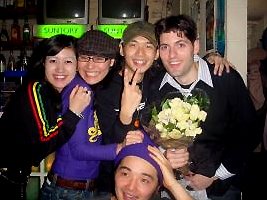 This being a monthly party, I’ve gone several times since December’s debut, hence pictures in different clothes. The flowers were from Maki for my birthday. Viewers will be pleased to know that I’ve since done away with the long hairdo. I don’t know what I was thinking other than that it was winter and my head was cold.
This being a monthly party, I’ve gone several times since December’s debut, hence pictures in different clothes. The flowers were from Maki for my birthday. Viewers will be pleased to know that I’ve since done away with the long hairdo. I don’t know what I was thinking other than that it was winter and my head was cold.
Posted by
ジェフリー
at
6:15 AM
1 comments
![]()





